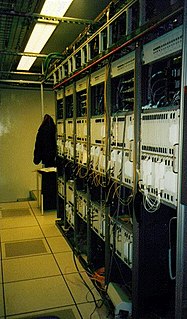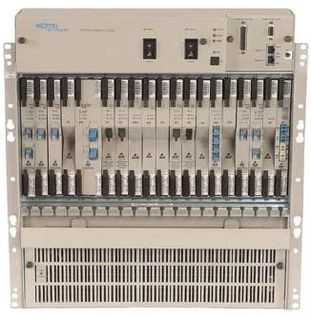This page is based on this
Wikipedia article Text is available under the
CC BY-SA 4.0 license; additional terms may apply.
Images, videos and audio are available under their respective licenses.
Multiprotocol Label Switching (MPLS) is a routing technique in telecommunications networks that directs data from one node to the next based on short path labels rather than long network addresses, thus avoiding complex lookups in a routing table and speeding traffic flows. The labels identify virtual links (paths) between distant nodes rather than endpoints. MPLS can encapsulate packets of various network protocols, hence the "multiprotocol" reference on its name. MPLS supports a range of access technologies, including T1/E1, ATM, Frame Relay, and DSL.

Synchronous optical networking (SONET) and synchronous digital hierarchy (SDH) are standardized protocols that transfer multiple digital bit streams synchronously over optical fiber using lasers or highly coherent light from light-emitting diodes (LEDs). At low transmission rates data can also be transferred via an electrical interface. The method was developed to replace the plesiochronous digital hierarchy (PDH) system for transporting large amounts of telephone calls and data traffic over the same fiber without the problems of synchronization.

Network topology is the arrangement of the elements of a communication network. Network topology can be used to define or describe the arrangement of various types of telecommunication networks, including command and control radio networks, industrial fieldbusses, and computer networks.
The data layer, or layer 2, is the second layer of the seven-layer OSI model of computer networking. This layer is the protocol layer that transfers data between adjacent network nodes in a wide area network (WAN) or between nodes on the same local area network (LAN) segment. The data link layer provides the functional and procedural means to transfer data between network entities and might provide the means to detect and possibly correct errors that may occur in the physical layer.
Resilient Packet Ring (RPR), also known as IEEE 802.17, is a protocol standard designed for the optimized transport of data traffic over optical fiber ring networks. The standard began development in November 2000 and has undergone several amendments since its initial standard was completed in June 2004. The amended standards are 802.17a through 802.17d, the last of which was adopted in May 2011. It is designed to provide the resilience found in SONET/SDH networks but, instead of setting up circuit oriented connections, provides a packet based transmission, in order to increase the efficiency of Ethernet and IP services.

A metropolitan-area Ethernet, Ethernet MAN, or metro Ethernet network is a metropolitan area network (MAN) that is based on Ethernet standards. It is commonly used to connect subscribers to a larger service network or the Internet. Businesses can also use metropolitan-area Ethernet to connect their own offices to each other.
Connection-oriented communication is a network communication mode in telecommunications and computer networking, where a communication session or a semi-permanent connection is established before any useful data can be transferred, and where a stream of data is delivered in the same order as it was sent. The alternative to connection-oriented transmission is connectionless communication, for example the datagram mode communication used by the IP and UDP protocols, where data may be delivered out of order, since different network packets are routed independently, and may be delivered over different paths.

A computer network is a digital telecommunications network which allows nodes to share resources. In computer networks, computing devices exchange data with each other using connections between nodes. These data links are established over cable media such as wires or optic cables, or wireless media such as Wi-Fi.
Ethernet Over SDH or Ethernet over SONET refers to a set of protocols which allow Ethernet traffic to be carried over synchronous digital hierarchy networks in an efficient and flexible way. The same functions are available using SONET.
ITU-T defines an Optical Transport Network (OTN) as a set of Optical Network Elements (ONE) connected by optical fiber links, able to provide functionality of transport, multiplexing, switching, management, supervision and survivability of optical channels carrying client signals. An ONE may Re-time, Re-Amplify, Re-shape (3R) but it does not have to be 3R – it can be purely photonic.
Provider Backbone Bridge Traffic Engineering (PBB-TE) is an approved telecommunications networking standard, IEEE 802.1Qay-2009. PBB-TE adapts Ethernet technology to carrier class transport networks. It is based on the layered VLAN tags and MAC-in-MAC encapsulation defined in IEEE 802.1ah, but it differs from PBB in eliminating flooding, dynamically created forwarding tables, and spanning tree protocols. Compared to PBB and its predecessors, PBB-TE behaves more predictably and its behavior can be more easily controlled by the network operator, at the expense of requiring up-front connection configuration at each bridge along a forwarding path. PBB-TE Operations, Administration, and Management (OAM) is usually based on IEEE 802.1ag. It was initially based on Nortel's Provider Backbone Transport (PBT).
Broadcast radiation is the accumulation of broadcast and multicast traffic on a computer network. Extreme amounts of broadcast traffic constitute a broadcast storm. A broadcast storm can consume sufficient network resources so as to render the network unable to transport normal traffic. A packet that induces such a storm is occasionally nicknamed a Chernobyl packet.
In telecommunications, subnetwork connection protection (SNCP), is a type of protection mechanism associated with synchronous optical networks such as synchronous digital hierarchy (SDH).

An optical mesh network is a type of optical telecommunications network employing wired fiber-optic communication or wireless free-space optical communication in a mesh network architecture.
Link protection is designed to safeguard networks from failure. Failures in high-speed networks have always been a concern of utmost importance. A single fiber cut can lead to heavy losses of traffic and protection-switching techniques have been used as the key source to ensure survivability in such networks. Survivability can be addressed in many layers in a network and protection can be performed at the physical layer, Layer 2 and Layer 3 (IP).








